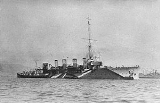
Adventure class cruiser
Encyclopedia
The Adventure class was a two ship class of scout cruiser
Scout cruiser
A scout cruiser was a type of warship of the early 20th Century, which were smaller, faster, more lightly armed and armoured than protected cruisers or light cruisers, but larger than contemporary destroyers...
serving with the Royal Navy
Royal Navy
The Royal Navy is the naval warfare service branch of the British Armed Forces. Founded in the 16th century, it is the oldest service branch and is known as the Senior Service...
in World War I
World War I
World War I , which was predominantly called the World War or the Great War from its occurrence until 1939, and the First World War or World War I thereafter, was a major war centred in Europe that began on 28 July 1914 and lasted until 11 November 1918...
, and consisting of the ships HMS Adventure
HMS Adventure (1904)
HMS Adventure was an Adventure class scout cruiser which served with the Royal Navy before and during the First World War. She was built by Armstrong Whitworth of Elswick, Tyne and Wear, being laid down on 7 January 1904 and launched on 8 September 1904.-Career:In April 1907 she collided with, and...
and HMS Attentive
HMS Attentive (1904)
HMS Attentive was an Adventure class scout cruiser of the Royal Navy. She was built by Armstrong Whitworth at their yards at Elswick, Tyne and Wear and launched on 24 November 1904...
.
Design
As with the ForwardForward class cruiser
The Forward class was a two ship class of scout cruiser serving with the Royal Navy in World War I, and consisting of the ships HMS Forward and HMS Foresight.-Design:...
, Pathfinder
Pathfinder class cruiser
The Pathfinder class was a two ship class of scout cruiser serving with the Royal Navy in World War I, and consisting of the ships HMS Pathfinder and HMS Patrol....
and Sentinel
Sentinel class cruiser
The Sentinel class was a two ship class of scout cruiser serving with the Royal Navy, and consisting of the ships HMS Sentinel and HMS Skirmisher.-History:...
classes, they were designed to work in company with destroyer
Destroyer
In naval terminology, a destroyer is a fast and maneuverable yet long-endurance warship intended to escort larger vessels in a fleet, convoy or battle group and defend them against smaller, powerful, short-range attackers. Destroyers, originally called torpedo-boat destroyers in 1892, evolved from...
flotilla
Flotilla
A flotilla , or naval flotilla, is a formation of small warships that may be part of a larger fleet. A flotilla is usually composed of a homogeneous group of the same class of warship, such as frigates, destroyers, torpedo boats, submarines, gunboats, or minesweepers...
s but soon proved too slow for this role as newer destroyers outpaced them. They were the only one of the four pairs of Scout cruisers of this group to have four funnels. The last of the group, they were the considered the best of the four designs and influenced future Admiralty
Admiralty
The Admiralty was formerly the authority in the Kingdom of England, and later in the United Kingdom, responsible for the command of the Royal Navy...
in-house designs. They were originally to be named the Eddystone class, but the name was altered prior to construction.
The two ships were built by Armstrong Whitworth
Armstrong Whitworth
Sir W G Armstrong Whitworth & Co Ltd was a major British manufacturing company of the early years of the 20th century. Headquartered in Elswick, Newcastle upon Tyne, Armstrong Whitworth engaged in the construction of armaments, ships, locomotives, automobiles, and aircraft.-History:In 1847,...
, of Elswick, Tyne and Wear
Elswick, Tyne and Wear
Elswick is a ward of the city of Newcastle upon Tyne, England, in the western part of the city, bordering the river Tyne. One of the earliest references to the coal mining industry of the north east occurs in 1330, when it was recorded that the Prior of Tynemouth let a colliery, called Heygrove, at...
and launched in 1904. Not long after completion two additional 12 pounder guns were added and the 3 pounder gun
3 pounder gun
3 pounder gun, 3 pounder, 3-pdr or QF 3-pdr is an abbreviation typically referring to a gun which fired a projectile weighing approximately 3 pounds...
s were replaced with six 6 pounders. In 1911-12 they were rearmed with nine 4 inch guns. Although the class had been rearmed with 4 inch guns, these were outranged by those of many German destroyers and by the end of the war she carried a gun armament of two 6 inch guns six 4 inch guns and a 3 inch anti-aircraft gun. The Adventure class ships also had a clipper bow (a bow that curves forward as it rises from the water).
In common with the other scout cruisers, their main failings were their short range and low speed, which made them incapable of keeping up with the destroyer flotillas they were meant to be leading, and unable to operate far from friendly ports. After the end of the war, the remaining scout cruisers, including the two of the Adventure class, were phased out of operation with the Navy.
Ships
- HMS AdventureHMS Adventure (1904)HMS Adventure was an Adventure class scout cruiser which served with the Royal Navy before and during the First World War. She was built by Armstrong Whitworth of Elswick, Tyne and Wear, being laid down on 7 January 1904 and launched on 8 September 1904.-Career:In April 1907 she collided with, and...
- launched on 8 September 1904, sold for scrapping on 3 March 1920. - HMS AttentiveHMS Attentive (1904)HMS Attentive was an Adventure class scout cruiser of the Royal Navy. She was built by Armstrong Whitworth at their yards at Elswick, Tyne and Wear and launched on 24 November 1904...
- launched on 24 November 1904, sold for scrapping on 12 April 1920.

